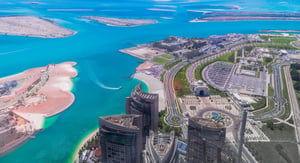In Q2 2025, the ValuStrat Price Index (VPI) for the residential sector in Abu Dhabi recorded accelerated growth, rising by 2.2 percent quarterly and 8.1 percent annually, reaching 128.3 points based on a 100-point scale set in Q1 2021. The increase is primarily driven by robust performance in the freehold apartment market. Villa prices also saw a notable increase of 2.6 percent QoQ and 10.1 percent YoY, reaching 138.2 points.
The ValuStrat Abu Dhabi Real Estate Review for Q2 2025 presents a detailed analysis of the emirate’s real estate markets across residential, office, retail, hospitality, and industrial sectors. The report highlights significant growth driven by strong demand, improving economic conditions, and strategic developments.
Apartment prices increased by 1.7 percent quarterly and 5.9 percent annually, marking the highest annual growth rate in three years. The residential rental VPI grew by 1.5 percent quarterly and 9.5 percent annually to reach 122.8 points, with apartment rents outpacing villa rents, rising by 2 percent QoQ and 12.5 percent YoY. Villa rents increased by 7 percent YoY but remained stable in the first half of the year.
Despite limited new housing supply—only 7.1 percent of the projected 2025 pipeline delivered in the first half of the year—approximately 33,000 new residential units are expected over the next five years. Sales activity rebounded after a subdued first quarter, with off-plan transactions rising by 53.1 percent QoQ, although they were still lower than the previous year by 51.8 percent. Ready home sales grew by 6.4 percent QoQ and 3 percent YoY, with an average ticket size of AED2.4 million.
Read more | Abu Dhabi real estate: Top luxury properties in Q1 2025
Office market insights
The office market in Abu Dhabi is experiencing strong demand, with asking rents increasing by 28.3 percent annually and 6.1 percent quarterly. The average asking rent reached AED860 per sq m, driven by high occupancy levels in central business districts. The total office stock in the city stands at approximately 3.9 million sq m (42 million sq ft), with Masdar City Square recently completed, adding 50,000 sq m to supply.
Retail sector performance
The retail sector also showed resilience, with shopping center stock at 1.95 million sq m (20.9 million sq ft) GLA. Notable expansions, such as the redevelopment of Al Jimi Mall, are set to increase total built-up area significantly. Aldar’s retail assets reported a 12 percent YoY growth in revenue, with Yas Mall maintaining a high occupancy rate of 98 percent.
The UAE’s e-commerce market is projected to exceed AED48.5 billion by 2028, further enhancing the retail landscape in Abu Dhabi.

Hospitality sector developments
As of April 2025, Abu Dhabi’s hospitality sector reported an occupancy rate of 83.7 percent, reflecting a 1.5 percent increase from the previous year. The Average Daily Rate (ADR) for hotels was AED623, up 25.1 percent annually, with Revenue Per Available Room (RevPAR) increasing by 26.8 percent to AED521. The sector is further set to benefit from a new Disney theme park resort on Yas Island, which is expected to boost demand in tourism and hospitality.
“The hospitality sector delivered exceptional results, with significant annual growth in occupancy and revenue metrics, underpinned by strong tourism activity. The recent announcement by The Walt Disney Company and Miral to develop a new Disney theme park resort on Yas Island is expected to further boost long-term demand in the hospitality and tourism sectors,” remarked Haider Tuaima, managing director & head of Real Estate Research, ValuStrat.
Industrial market overview
Additionally, the industrial sector in Abu Dhabi is thriving, with industrial property asking prices experiencing double-digit annual growth, averaging 15.9 percent. Warehouse prices range between AED1,668 and AED4,736 per sq m, influenced by facility specifications. The recent establishment of a vaccine distribution hub at KEZAD underscores the sector’s growth potential.
Macro-economic context
Moreover, the macroeconomic environment is favorable, with the World Bank projecting a 4.6 percent growth rate for the UAE’s economy in 2025, bolstered by strong non-oil sector performance. Abu Dhabi’s GDP reached AED291 billion in Q1 2025, with non-oil activities now comprising the majority of GDP at 56.2 percent. The population of Abu Dhabi city was reported at 2.85 million, indicating strong demographic trends supporting real estate demand.








